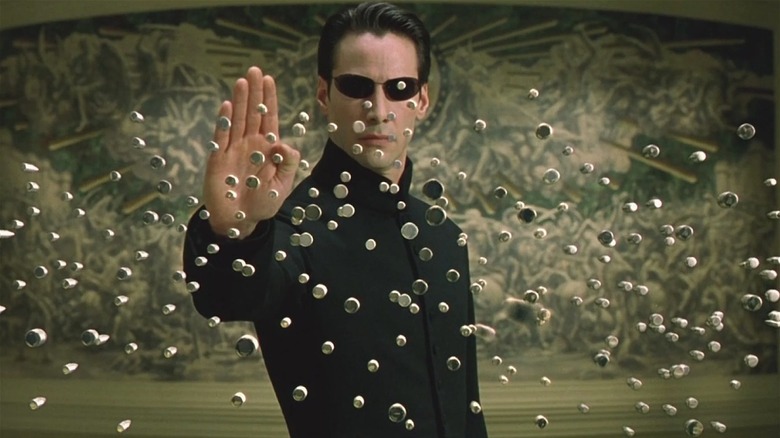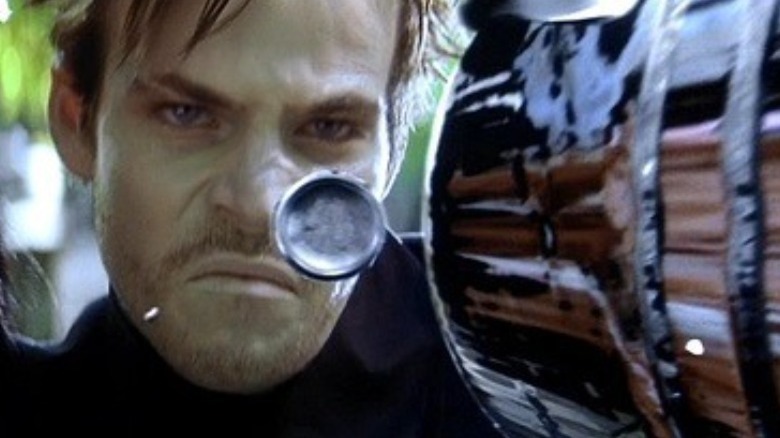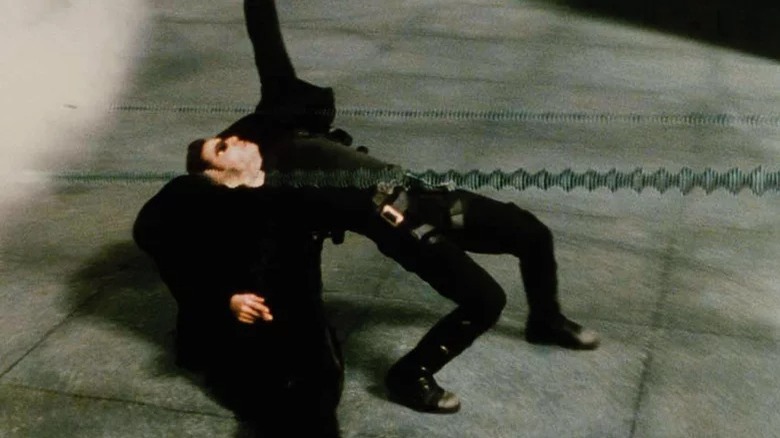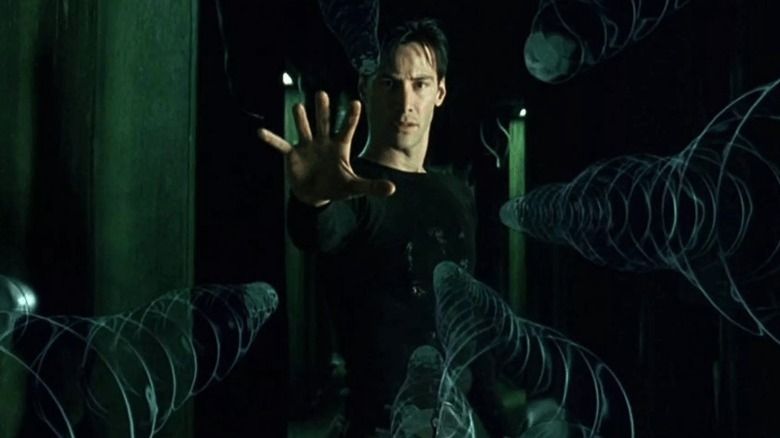The Matrix's Original Bullet-Time Method Was A Little Too Risky To Work
The term "bullet-time" was first used in the original script for "The Matrix," in the context of the memorable sequence in which bullets glide through the air in slow motion while Neo (Keanu Reeves) bends back and evades them like a boss. The effect is still incredibly cool to see, even after so many years since the film's release in 1999.
The bullet-time effect is usually achieved with the aid of multiple cameras to give the impression of time slowing down or coming to a standstill. Created by John Gaeta and Manex Visual Effects, bullet-time, also known as the Matrix effect, helped capture moments in slow motion that were otherwise unfilmable, such as following bullet trajectories and shattering glass during dynamic action sequences.
While "The Matrix" cemented the practical, believable use of the trope, a host of video games put this mechanic to good use, with key examples being the "Max Payne" trilogy and the John Woo-inspired "Stranglehold." "Deadeye" mode in the "Red Dead Redemption" franchise.
But back in 1999, pulling this off effectively required an extreme transformation of both time and space, meaning that the original method that was proposed for pulling off the Neo bullet scene in "The Matrix" posed its own risks and limitations.
A brief history of bullet-time
Per Film School Rejects, the core concept of bullet-time can be traced back to Japanese cel animation, and the first instance of it being used loosely in the medium is the 1966 anime, "Speed Racer." The technique was not refined at that point and hinged more on experimental approaches to accomplishing brief shots using still cameras, such as in the 1995 re-release of the "Like a Rolling Stone" music video by "The Rolling Stones."
The earliest film to feature a bullet-dodging scene using a lesser-evolved version of the technique was the 1981 martial arts movie, "Kill and Kill Again." Interestingly, 1998's "Blade" also featured computer-generated bullets in order to showcase the superhuman speed and agility of vampires that help them dodge bullets (featured during Blade's encounter with Deacon Frost), and the sequence was accomplished using slow-motion footage.
Another example is "Lost in Space," released in the same year as "Blade," which used a version of bullet-time in order to dramatize the sequence in which the ship engages hyperdrive, and the passengers can be seen floating in slow-motion.
John Woo warrants a special mention yet again, as his "Hard-Boiled" can be deemed a major influence on the Wachowskis when it comes to crafting highly-stylized action sequences — especially the aspect of gun-fu that Woo's film helped to pioneer. Although used in various iterations throughout several kinds of media, bullet-time as a technique was not quite polished or realized prior to "The Matrix," which can be attributed to the dearth of technological tools that would aid in achieving this effect.
Creating 'liquid space'
The Wachowskis knew that bringing their ideas for "The Matrix" to life would be an ambitious undertaking, as several scenes demanded the best forms of movie magic in order for the scenes to seem believable. The visual aesthetic is incredibly important to this film, especially when the characters are inside the simulacrum, as it adds layers of meaning to the central allegory while looking wickedly cool onscreen.
The general idea behind pulling off the bullet-time sequences was that the camera would function at a normal speed but the movements would be captured in slow motion. This would allow the camera to pick up on the most minute details and incorporate varying points of view in slow motion, creating a "liquid space" of sorts. As per Wired, Lana Wachowski explained that the idea was to "push at the boundaries of reality," but this effect could not be achieved from a practical filmmaking standpoint.
Although the Wachowskis initially put forth the idea of putting "a slow-motion camera on a high-speed rocketlike device" in order to achieve the effect, this was impractical on many levels and carried the risk of equipment damage. Hence, the best way to achieve the bullet-time effect at the time was to create the illusion digitally, which worked fairly well in the film's favor.
How The Matrix pulled off bullet-time
The most memorable bullet-time scene in question in "The Matrix" involves Neo being cornered by an Agent on a rooftop and the former utilizing his abilities as The One to manipulate space-time and dodge the bullets in slow-motion in the process. That was no small feat to pull off in 1999 — today, bullet-time effects are used with the aid of free viewpoint television or FTV, which had not fully matured as a technique during the time "The Matrix" was made. So, how did the Wachowskis pull this off?
According to the Wired article referenced above, green screen technology was involved, and Reeves was connected to wires so as to be able to pull off the "arching backward in superhuman fashion effect," which mimicked a semi-circle trajectory rigged with 120 still cameras. As Reeves implemented the action of falling backward, still and motion capture cameras were used in tandem, while the entire shot came together with the aid of digital bullets and effects that granted the illusion of time standing still — a feat that took two years to put together and ended up costing an estimated $750,000 for that single shot.
Pierre Jasmin, who worked at Mass. Illusions during the time "The Matrix" was filmed, said in an interview that test shots for the bullet-time scenes included digitally "breaking down the actor into per-limb layers," which were polished with the aid of morphing and stabilization.
Clearly, a lot of work went into these sequences, and "The Matrix" pioneered the technique in stunning ways, utilizing interpolation and time-slice effects in a way that had never been done before. The rest is history.



